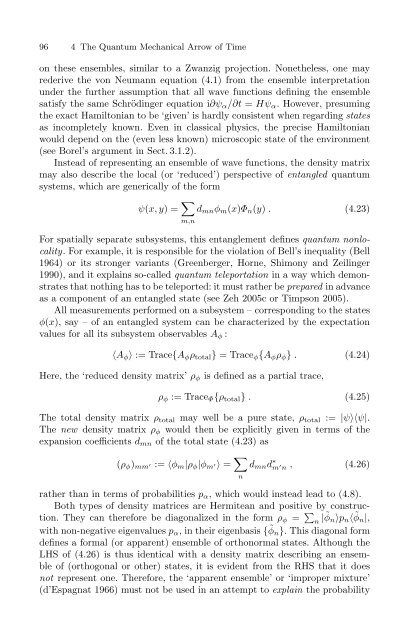The Physical Basis of The Direction of Time (The Frontiers ...
The Physical Basis of The Direction of Time (The Frontiers ...
The Physical Basis of The Direction of Time (The Frontiers ...
Create successful ePaper yourself
Turn your PDF publications into a flip-book with our unique Google optimized e-Paper software.
96 4 <strong>The</strong> Quantum Mechanical Arrow <strong>of</strong> <strong>Time</strong><br />
on these ensembles, similar to a Zwanzig projection. Nonetheless, one may<br />
rederive the von Neumann equation (4.1) from the ensemble interpretation<br />
under the further assumption that all wave functions defining the ensemble<br />
satisfy the same Schrödinger equation i∂ψ α /∂t = Hψ α . However, presuming<br />
the exact Hamiltonian to be ‘given’ is hardly consistent when regarding states<br />
as incompletely known. Even in classical physics, the precise Hamiltonian<br />
would depend on the (even less known) microscopic state <strong>of</strong> the environment<br />
(see Borel’s argument in Sect. 3.1.2).<br />
Instead <strong>of</strong> representing an ensemble <strong>of</strong> wave functions, the density matrix<br />
may also describe the local (or ‘reduced’) perspective <strong>of</strong> entangled quantum<br />
systems, which are generically <strong>of</strong> the form<br />
ψ(x, y) = ∑ m,n<br />
d mn φ m (x)Φ n (y) . (4.23)<br />
For spatially separate subsystems, this entanglement defines quantum nonlocality.<br />
For example, it is responsible for the violation <strong>of</strong> Bell’s inequality (Bell<br />
1964) or its stronger variants (Greenberger, Horne, Shimony and Zeilinger<br />
1990), and it explains so-called quantum teleportation in a way which demonstrates<br />
that nothing has to be teleported: it must rather be prepared in advance<br />
as a component <strong>of</strong> an entangled state (see Zeh 2005c or Timpson 2005).<br />
All measurements performed on a subsystem – corresponding to the states<br />
φ(x), say – <strong>of</strong> an entangled system can be characterized by the expectation<br />
values for all its subsystem observables A φ :<br />
〈A φ 〉 := Trace{A φ ρ total } =Trace φ {A φ ρ φ } . (4.24)<br />
Here, the ‘reduced density matrix’ ρ φ is defined as a partial trace,<br />
ρ φ := Trace Φ {ρ total } . (4.25)<br />
<strong>The</strong> total density matrix ρ total may well be a pure state, ρ total := |ψ〉〈ψ|.<br />
<strong>The</strong> new density matrix ρ φ would then be explicitly given in terms <strong>of</strong> the<br />
expansion coefficients d mn <strong>of</strong> the total state (4.23) as<br />
(ρ φ ) mm ′ := 〈φ m |ρ φ |φ m ′〉 = ∑ n<br />
d mn d ∗ m ′ n , (4.26)<br />
rather than in terms <strong>of</strong> probabilities p α , which would instead lead to (4.8).<br />
Both types <strong>of</strong> density matrices are Hermitean and positive by construction.<br />
<strong>The</strong>y can therefore be diagonalized in the form ρ φ = ∑ n | ˜φ n 〉p n 〈 ˜φ n |,<br />
with non-negative eigenvalues p α , in their eigenbasis { ˜φ n }. This diagonal form<br />
defines a formal (or apparent) ensemble <strong>of</strong> orthonormal states. Although the<br />
LHS <strong>of</strong> (4.26) is thus identical with a density matrix describing an ensemble<br />
<strong>of</strong> (orthogonal or other) states, it is evident from the RHS that it does<br />
not represent one. <strong>The</strong>refore, the ‘apparent ensemble’ or ‘improper mixture’<br />
(d’Espagnat 1966) must not be used in an attempt to explain the probability



![arXiv:1001.0993v1 [hep-ph] 6 Jan 2010](https://img.yumpu.com/51282177/1/190x245/arxiv10010993v1-hep-ph-6-jan-2010.jpg?quality=85)


![arXiv:1008.3907v2 [astro-ph.CO] 1 Nov 2011](https://img.yumpu.com/48909562/1/190x245/arxiv10083907v2-astro-phco-1-nov-2011.jpg?quality=85)








![arXiv:1002.4928v1 [gr-qc] 26 Feb 2010](https://img.yumpu.com/41209516/1/190x245/arxiv10024928v1-gr-qc-26-feb-2010.jpg?quality=85)
![arXiv:1206.2653v1 [astro-ph.CO] 12 Jun 2012](https://img.yumpu.com/39510078/1/190x245/arxiv12062653v1-astro-phco-12-jun-2012.jpg?quality=85)
